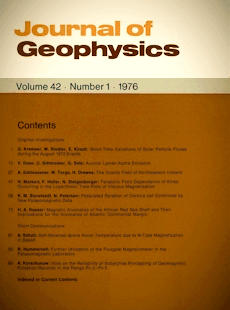Radial variation of the interplanetary magnetic field between 0.3 AU and 1.0 AU - observations by the Helios-1 spacecraft
Article Sidebar

Vols. 1-18 (1924-1944), ISSN 0044-2801
Main Article Content
Abstract
We have investigated the radial dependence of the radial and azimuthal components and the magnitude of the interplanetary magnetic field obtained by the Technical University of Braunschweig magnetometer experiment on-board of Helios-1 from December 10, 1974 to first perihelion on March 15, 1975. Absolute values of daily averages of each quantity have been employed. The regression analysis based on power laws leads to 2.55 γ x r-2.0 , 2.26 γ x r-1.0 and F = 5.53 γ x r-1.6 with standard deviations of 2.5 γ, 2.0 γ and 3.2 γ for the radial and azimuthal components and magnitude, respectively. Here r is the radial distance from the Sun in astronomical units. The results are compared with results obtained for Mariners 4, 5 and 10 and Pioneers 6 and 10. The differences are probably due to different epochs in the solar cycle and the different statistical techniques used.
 ARK: https://n2t.net/ark:/88439/y077849
ARK: https://n2t.net/ark:/88439/y077849
Permalink: https://geophysicsjournal.com/article/113
Article Details
References
Behannon, K.W. (1975) Variation of the interplanetary magnetic field with heliocentric distance, GSFC Rep. X-692-75-143, June
Coleman, P.J., Smith, E., Jr., Davis, L., Jones, E.D. (1969) The radial dependence of the interplanetary magnetic field: 1.0-1,5 AU. J. Geophys. Res. 74:2826-2850
Jokipii, J.R. (1975) Fluctuations and the radial variation of the interplanetary magnetic field. Geophys. Res. Lett. 2:473-475
Musmann, G., Neubauer, F.M., Maier, A., Lammers, E. (1975) Das Forstensonden-Magnetfeldexperiment (E2). Raumfahrtforschung 19:232-237
Neugebauer, M. (1975) Large scale and solar-cycle variations of the solar wind. Space Sci. Rev. 17:221-254
Parker, E.N. (1963) Interplanetary dynamical processes. Interscience, New York
Parker, G.D., Jokipii, J.R. (1976) The spiral structure of the interplanetary magnetic field. Geophys. Res. Lett. 3:561-564
Rosenberg, R.L., Coleman, P.J., Jr. (1973) The radial dependence of the interplanetary magnetic field: 1.0-0.7 AU, Institute of Geophysical and Planetary Physics No. 1196-26, Univ. of California, Los Angeles
Smith, E.J. (1974) Radial gradients in the interplanetary magnetic field between 1.0 and 4.3 AU: Pioneer 10, Jet Propulsion Lab., Pasadena CA, USA
Villante, U., Mariani, F. (1975) On the radial variation of the interplanetary magnetic field: Pioneer 6. Geophys. Res. Lett. 2:73-74











